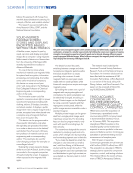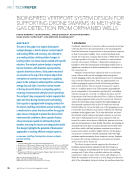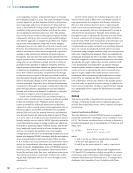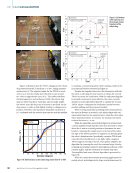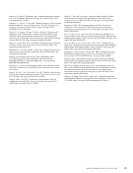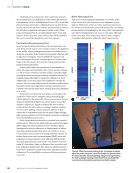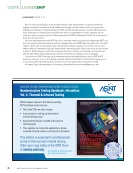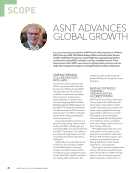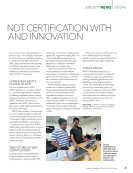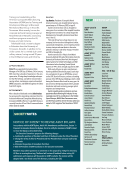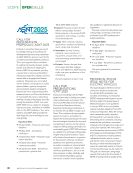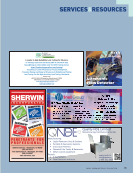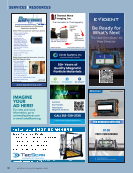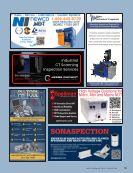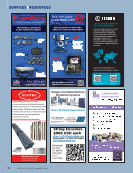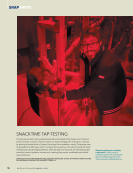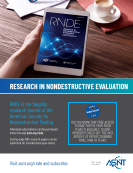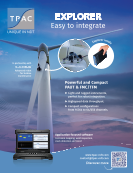believe this approach will change how
we think about bioelectronic sensing. It’s
a simple, effective, and scalable solution.”
This research was sponsored by the
Army Research Office, CPRIT, and the
National Science Foundation.
SQUID-INSPIRED
FLEXIBLE SCREEN
STORES AND DISPLAYS
ENCRYPTED IMAGES
WITHOUT ELECTRONICS
A flexible screen, inspired in part by
squid, can store and display encrypted
images like a computer—using magnetic
fields instead of electronics. Researchers
from the University of Michigan (UM)
recently reported the innovation in
Advanced Materials.
“It’s one of the first times where
mechanical materials use magnetic fields
for system-level encryption, information
processing, and computing. And unlike
some earlier mechanical computers,
this device can wrap around your
wrist,” said Joerg Lahann, the Wolfgang
Pauli Collegiate Professor of Chemical
Engineering and co-corresponding
author of the study.
The innovative screen could be
applied in scenarios where light or power
sources are impractical, including with
clothing, stickers, ID badges, barcodes,
and ebook readers. It displays a public
image when near a regular magnet and a
private, encrypted one when placed over
a complex array of magnets that func-
tions as an encryption key.
“This device can be programmed to
show specific information only when
the right keys are provided. And there
is no code or electronics to be hacked,”
said Abdon Pena-Francesch, UM assis-
tant professor of materials science and
engineering and co-corresponding
author. “This could also be used for
color-changing surfaces—for example, on
camouflaged robots.”
Shaking the screen erases its display,
similar to an Etch-A-Sketch, but the image
is encoded in the magnetic properties
of beads inside the screen. It reappears
when exposed to the magnetic field
again.
The beads function like pixels,
switching between orange and white
hemispheres. Magnetic particles within
the beads enable them to rotate,
providing color contrast. A weak
magnetic field can reprogram pixels
made with iron oxide particles, while
those with neodymium require a stronger
magnetic pulse.
By holding the screen over a grid of
magnets with varying strengths and
orientations, the pixels’ polarization can
be selectively changed, encoding an
image. Private images can be displayed
by using a second magnetic grid that
reprograms certain pixels, while the
public image remains accessible under a
standard magnet.
Multiple private images can be gener-
ated from a single public image, each
requiring a unique key. The decoding
keys can also be programmed to only
work with specific encoding keys, for
extra security.
The researchers designed the screen’s
resolution by studying squids and octo-
puses, which change color by expanding
and contracting pigment sacs in their skin.
“If you make the beads too small, the
changes in color become too small to
see,” said Zane Zhang, a UM doctoral
student and the study’s first author. “The
squid’s pigment sacs have optimized size
and distribution to give high contrast, so
we adapted our device’s pixels to match
their size.”
The research was funded by the
American Chemical Society Petroleum
Research Fund and the National Science
Foundation. An invention disclosure has
been filed with the assistance of UM
Innovation Partnerships. Jeffery Raymond
is a co-author of the study, along with
Zhang, Lahann, and Pena-Francesch. The
paper can be accessed at https://doi.
org/10.1002/adma.202406149.
TRIGO ACQUIRES
CONTROREUPE TO
BOLSTER AEROSPACE
AND DEFENSE QUALITY
CONTROL CAPABILITIES
TRIGO announced the acquisition of
Controreupe, a specialized nonde-
structive testing (NDT) company based
in Saint-Geneviève-des-Bois, France,
on 16 January 2025. This acquisition
strengthens TRIGO’s position in the
industrial quality control market and
expands its service portfolio in the aero-
space and defense sectors. Controreupe
specializes in penetrant testing and 3D
measurement of complex parts.
With 30 years of expertise,
Controreupe generates annual revenues
of €3 million (US$3.12 million) from NDT.
The acquisition is a key step in TRIGO’s
strategic plan to expand its component
inspection, control, and testing solutions.
This initiative follows the recent achieve-
ment of TRIGO’s Aerospace, Defense,
SCANNER
|
INDUSTRYNEWS
The palm-sized, transparent square screen contains orange and white beads, roughly the size of
sand grains, arranged in a smaller square inside. By holding the screen near magnets of varying
strengths, the magnetic properties of specific pixels can be altered, allowing different magnet
arrays to program different images. When held over a magnet, the magnetic pixels in the screen
flip to display the University of Michigan block M.
10
M AT E R I A L S E V A L U AT I O N • A P R I L 2 0 2 5
CREDIT:
JEREMY
LITTLE/MICHIGAN
ENGINEERING
we think about bioelectronic sensing. It’s
a simple, effective, and scalable solution.”
This research was sponsored by the
Army Research Office, CPRIT, and the
National Science Foundation.
SQUID-INSPIRED
FLEXIBLE SCREEN
STORES AND DISPLAYS
ENCRYPTED IMAGES
WITHOUT ELECTRONICS
A flexible screen, inspired in part by
squid, can store and display encrypted
images like a computer—using magnetic
fields instead of electronics. Researchers
from the University of Michigan (UM)
recently reported the innovation in
Advanced Materials.
“It’s one of the first times where
mechanical materials use magnetic fields
for system-level encryption, information
processing, and computing. And unlike
some earlier mechanical computers,
this device can wrap around your
wrist,” said Joerg Lahann, the Wolfgang
Pauli Collegiate Professor of Chemical
Engineering and co-corresponding
author of the study.
The innovative screen could be
applied in scenarios where light or power
sources are impractical, including with
clothing, stickers, ID badges, barcodes,
and ebook readers. It displays a public
image when near a regular magnet and a
private, encrypted one when placed over
a complex array of magnets that func-
tions as an encryption key.
“This device can be programmed to
show specific information only when
the right keys are provided. And there
is no code or electronics to be hacked,”
said Abdon Pena-Francesch, UM assis-
tant professor of materials science and
engineering and co-corresponding
author. “This could also be used for
color-changing surfaces—for example, on
camouflaged robots.”
Shaking the screen erases its display,
similar to an Etch-A-Sketch, but the image
is encoded in the magnetic properties
of beads inside the screen. It reappears
when exposed to the magnetic field
again.
The beads function like pixels,
switching between orange and white
hemispheres. Magnetic particles within
the beads enable them to rotate,
providing color contrast. A weak
magnetic field can reprogram pixels
made with iron oxide particles, while
those with neodymium require a stronger
magnetic pulse.
By holding the screen over a grid of
magnets with varying strengths and
orientations, the pixels’ polarization can
be selectively changed, encoding an
image. Private images can be displayed
by using a second magnetic grid that
reprograms certain pixels, while the
public image remains accessible under a
standard magnet.
Multiple private images can be gener-
ated from a single public image, each
requiring a unique key. The decoding
keys can also be programmed to only
work with specific encoding keys, for
extra security.
The researchers designed the screen’s
resolution by studying squids and octo-
puses, which change color by expanding
and contracting pigment sacs in their skin.
“If you make the beads too small, the
changes in color become too small to
see,” said Zane Zhang, a UM doctoral
student and the study’s first author. “The
squid’s pigment sacs have optimized size
and distribution to give high contrast, so
we adapted our device’s pixels to match
their size.”
The research was funded by the
American Chemical Society Petroleum
Research Fund and the National Science
Foundation. An invention disclosure has
been filed with the assistance of UM
Innovation Partnerships. Jeffery Raymond
is a co-author of the study, along with
Zhang, Lahann, and Pena-Francesch. The
paper can be accessed at https://doi.
org/10.1002/adma.202406149.
TRIGO ACQUIRES
CONTROREUPE TO
BOLSTER AEROSPACE
AND DEFENSE QUALITY
CONTROL CAPABILITIES
TRIGO announced the acquisition of
Controreupe, a specialized nonde-
structive testing (NDT) company based
in Saint-Geneviève-des-Bois, France,
on 16 January 2025. This acquisition
strengthens TRIGO’s position in the
industrial quality control market and
expands its service portfolio in the aero-
space and defense sectors. Controreupe
specializes in penetrant testing and 3D
measurement of complex parts.
With 30 years of expertise,
Controreupe generates annual revenues
of €3 million (US$3.12 million) from NDT.
The acquisition is a key step in TRIGO’s
strategic plan to expand its component
inspection, control, and testing solutions.
This initiative follows the recent achieve-
ment of TRIGO’s Aerospace, Defense,
SCANNER
|
INDUSTRYNEWS
The palm-sized, transparent square screen contains orange and white beads, roughly the size of
sand grains, arranged in a smaller square inside. By holding the screen near magnets of varying
strengths, the magnetic properties of specific pixels can be altered, allowing different magnet
arrays to program different images. When held over a magnet, the magnetic pixels in the screen
flip to display the University of Michigan block M.
10
M AT E R I A L S E V A L U AT I O N • A P R I L 2 0 2 5
CREDIT:
JEREMY
LITTLE/MICHIGAN
ENGINEERING













